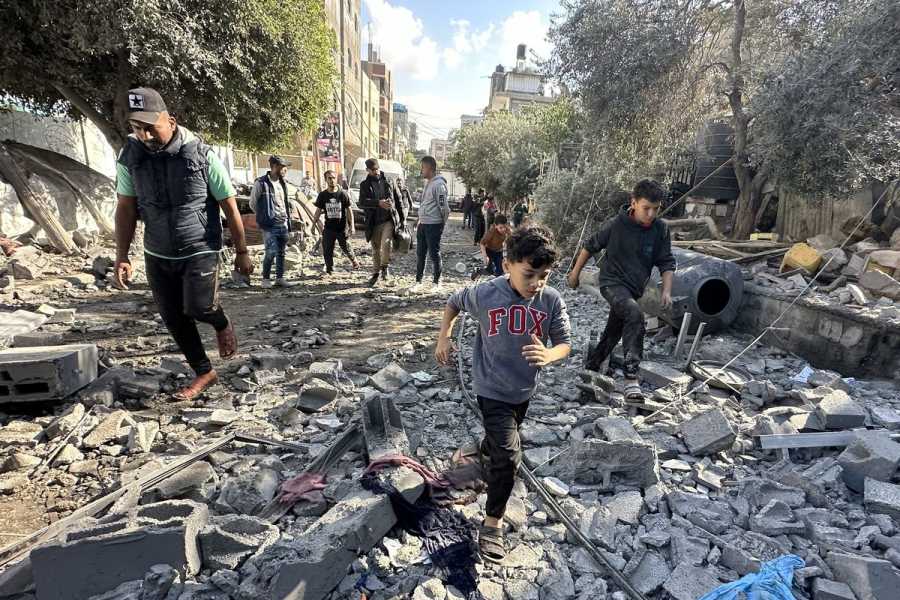Increasingly, civilians are running out of safe places to go.

Residents and civil defense teams conduct a search and rescue operation around the rubble of the building that collapsed following an Israeli attack on houses belonging to the Abu Hubeyze and Abu Ayesha families at the Nuseirat refugee camp in Deir al-Balah, Gaza, on December 6, 2023. Doaa Albaz/Anadolu/Getty Images Li Zhou is a politics reporter at Vox, where she covers Congress and elections. Previously, she was a tech policy reporter at Politico and an editorial fellow at the Atlantic.
Following a seven-day ceasefire, Israel resumed its bombing campaign in Gaza as part of its effort to, as its defense minister put it, “wipe this thing called Hamas, ISIS-Gaza, off the face of the earth,” warning civilians to evacuate to “safe zones” to avoid being killed. Such directives, however, are growing increasingly difficult to follow. As a revealing statement from the UN children’s agency, Unicef, makes clear, places safe from violence in Gaza — that also have the resources people need to survive — are not just scarce, they’re virtually nonexistent.
“There are no safe zones in Gaza,” James Elder, a Unicef spokesperson, told the BBC. “These are tiny patches of barren land. They have no water, no facilities, no shelter from the cold, no sanitation.”
Elder’s quote underscores the limitations that civilians in the region now face because of the Israeli government’s military offensive and because of longstanding restrictions on people’s movement. All told, Gaza is 140 square miles, smaller than a third the size of the city of Los Angeles, according to the Los Angeles Times. Its residents are limited in their ability to leave Gaza due to an ongoing blockade the territory has been under since 2007 and because Israel and Egypt, its two bordering countries, have refused to take in refugees. Mobility is also challenging since airstrikes have damaged roads in the territory and fuel remains extremely scarce.
After Hamas killed 1,200 people and kidnapped over 200 people on October 7 in a brutal attack that devastated Israel, the country declared war on the militant group that oversees Gaza.
Israel Defense Forces (IDF) spokespeople have repeatedly said the military is following international law in its air and ground war in Gaza; critics, however, have questioned those claims. Last week, an investigation from +972 and Local Call showed that Israel’s “expanded authorization for bombing non-military targets, the loosening of constraints regarding expected civilian casualties, and the use of an artificial intelligence system to generate more potential targets than ever before” all seem to have exacerbated the deadliness of the war.
Israel also claims it has given people adequate warning to evacuate areas that it’s targeting, though there have been questions about the efficacy of such systems. As the Washington Post reports, the country has used “airdropped leaflets, calls and texts” in order to point people to supposedly safe areas. Poor internet and cell service in Gaza, however, have meant that many civilians don’t receive these messages. Additionally, the messages can be confusing and contradictory: As the military onslaught has intensified, areas previously designated as safe no longer are.
Furthermore, any new safe zones the Israeli government has identified, including a strip of land called al-Mawasi in the south, are poised to face severe overcrowding as tens of thousands of people are squeezed into an “airport-sized area,” per Al Jazeera. In one case, a refugee shelter in central Gaza designed to hold 2,000 people was holding 37,900 displaced people, the UN said on November 23. So-called safe zones like al-Mawasi also lack basic resources like food and water, fueling concerns that many people staying there will die from disease, if not violence.
“If you are going to forcibly evacuate people, you cannot send hundreds of thousands [of] people to places where there is no water and no toilets. I genuinely mean no toilets. Every corner I had turned to, there was another 5,000 people who would appear overnight. They don’t have a single toilet, they don’t have a drop of water,” Elder said of his experience visiting Gaza. According to a physician Elder spoke with in Gaza, “safe zones will become zones of disease.”
As a result of these developments, the humanitarian crisis in Gaza is entering an even more severe phase following the ceasefire. Since the October 7 attack, Israel has relentlessly bombed Gaza, with the exception of the multi-day pause in late November. Its airstrikes and ground offensive had killed more than 14,000 Palestinians prior to the ceasefire, according to the Gaza Media Office.
Nearly 1,700 people have now been killed since the ceasefire ended, a stark death toll that has been caused, in part, by the fact that civilians in Gaza increasingly have nowhere left to go.
Why the humanitarian crisis in Gaza is getting even worse
The humanitarian crisis in Gaza has been dire for weeks. Many of its hospitals have closed. Insufficient aid has been allowed inside. Food and water supplies are dwindling, and fears of infectious disease are growing. According to a United Nations estimate, 1.9 million of the 2.3 million people in Gaza have been displaced since the beginning of this escalation in October.
Roughly 1 million people have been displaced from the north following the bombings in north Gaza in October and November, according to Al Jazeera. Israel is now targeting its airstrikes and ground attacks in the south as well, including in areas it previously directed people to evacuate to in Khan Younis and Rafah. These attacks are spurring yet another wave of casualties and displacements, as people struggle to find new safe zones.
For many civilians, getting to these safe havens has been near impossible, in part because they keep changing. While the Israeli government initially told people in the north to move south in order to avoid violence, it’s now attacking areas in the south, too. That has meant ongoing uncertainty for civilians seeking safety as they field inconsistent descriptions of where secure places are.
Recently, the Israeli government dropped leaflets in Khan Younis, one of the largest cities in southern Gaza, with QR codes connected to maps of areas where people can evacuate. This approach has been criticized by Palestinians, many of whom aren’t able to access those maps or who are being told to go to “safe zones” that are not secure or inhabitable.
Elder has pushed back on the idea that al-Mawasi, a 14-square-kilometer stretch of land near the Mediterranean Sea, can be considered a safe zone.
“It’s about 4 percent of Gaza and it would require 80 percent of the population to be there,” Elder told Sky News. “So here you definitely have zones of disease.” Sky News reporters have also visited the region and found little in the way of infrastructure for food distribution and other support.
The growing displacement of people across Gaza has raised humanitarian concerns even further, as the numbers that populate al-Mawasi are only expected to rise.
“This is an apocalyptic situation now because these are the remnants of a nation being driven into a pocket in the south,” UN undersecretary-general for humanitarian affairs Martin Griffiths told the Guardian. Elder’s dire assessment echoes this sentiment, highlighting how rampant overcrowding, ongoing airstrikes, and major supply shortages are continuing to put civilians in Gaza at serious risk.
Sourse: vox.com






